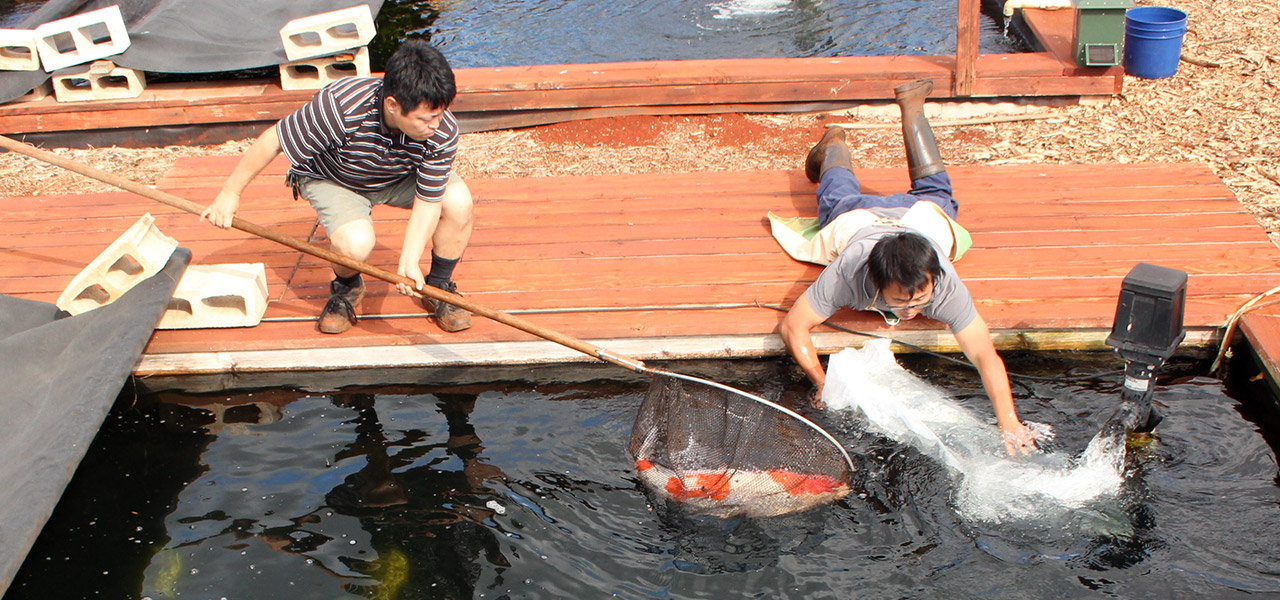
Use these tips to make a big difference in your Koi’s exhaustion and stress levels when bringing your koi to a show, moving them to a new pond, or any other time you have to relocate your pond fish.
The health and well-being of your koi is of the utmost importance to us and so we put together this guide on moving your fish safely, to ensure our friends are taken care of! Let us know any other questions you have on the process.
Take your time, be cautious, and you will have a successful move for your finned friends.
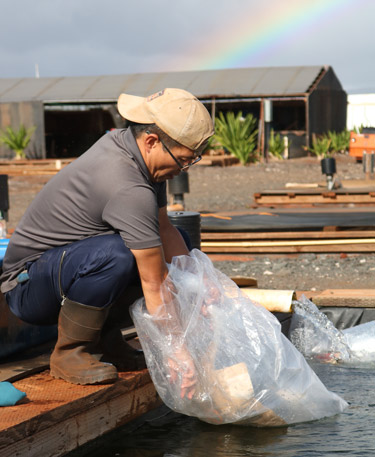
Table of Contents – Koi Transportation Tips
- The Best Way to Transport Large Fish
- Tips Prior to Moving Your Koi Fish
- After Transportation of Koi or Return From the Show
- Moving Pond Fish in Winter
Items for Koi Transportation
You will need a few important items for a moving your koi in a healthy fashion, our recommendations:
- Koi Transportation Plastic Bags
- Koi Packing Rubber Bands
- Pure Oxygen
- Strong Boxes – Alternate Cooler Option
- Salt
- Water Conditioner like ClorAm-x or Ultimate
How to Move Koi Video by Taro Kodama
Enjoy this video overview by Taro Kodama and read the detailed instructions on how to move koi below in the article.
We send thousands of online koi for sale by mail every year and while the process seems challenging, there are a few important things to remember as mentioned in this article. Water quality is everything and you must prepare the koi weeks in advance for their long and stressful journey.
When we sell koi, they have already been prepared to be sold and have been in holding tanks. Just like us, you must prepare your koi for transportation and for example, stop feeding them in advance of the trip to keep water quality high.
You may also consider reading our koi care after receiving blog post that dives into the subject of how to take care of koi after receiving from a koi distributor.
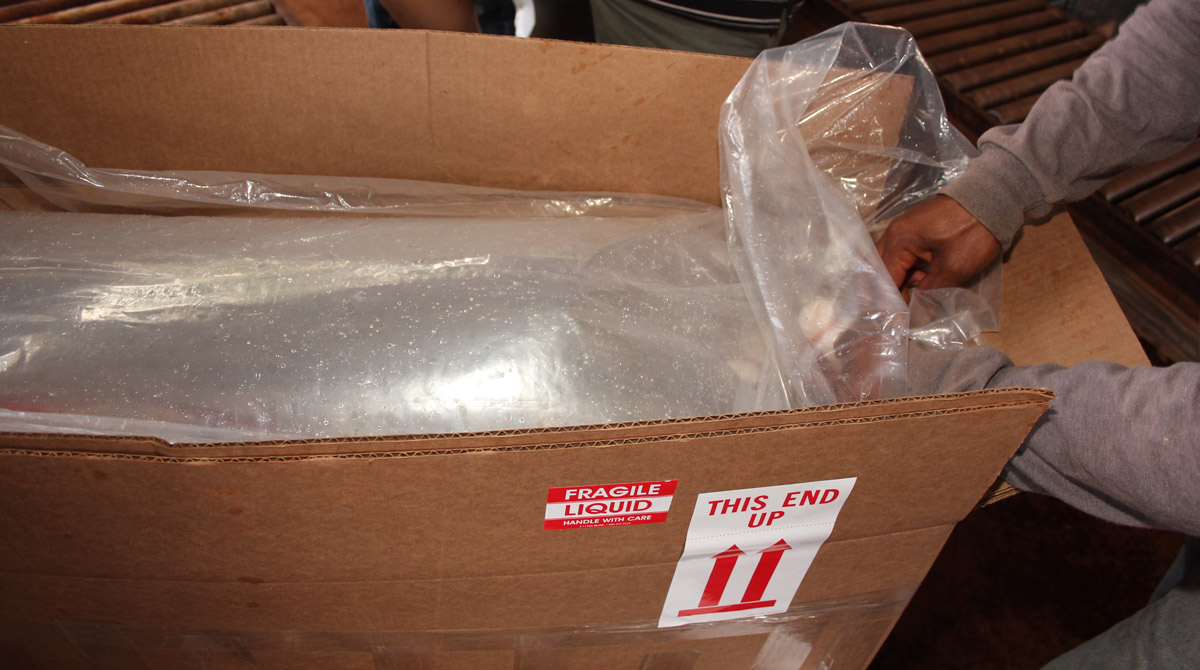
What is The Best Way to Transport Large and Small Koi Fish?
Transporting large fish can be an extra challenge due to their size and requirements. At any size, you must prepare these items and follow the steps to pack.
Order of Packing Koi in Transport Bag
- Put a few buckets of water, salt and ultimate/water conditioner
- Gently place koi in one of your koi transport bags
- Inject pure oxygen
- Close it with rubber bands – Triple Check for Security!!
- Place transport bag in a box for easy handling
Please make sure Koi’s body is covered by water, at least 90%.
For a single koi bag, add a half of a handful of salt, and a few capfuls of Ultimate/ClorAm X.
If you pack your Koi right, it should last 24 hours. If you pack less Koi right, it will last longer.
Once they are packed, the best thing we can do for them is not to bother them. Leave them alone in the dark.
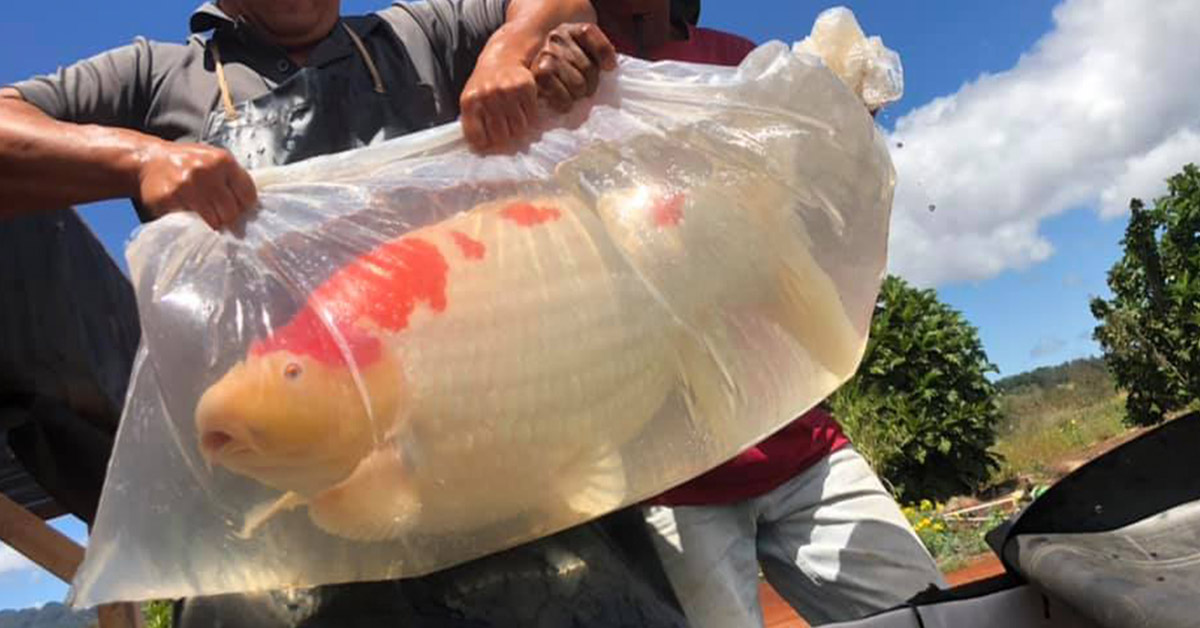
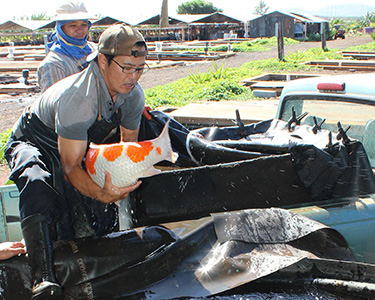 Moving Koi Long Distances?
Moving Koi Long Distances?
If you plan to ship Koi by air, you still need to box your Koi. If you plan to travel by car, you have 2 options. One is to box your Koi as discussed already. The other option is to use a transportation tank in your truck or van.
The benefit is that you do not have to pack your Koi one by one. This will not only save you time but allow for more koi to fit in your moving space.
If you are not confident in packing your Koi, especially the big ones, we highly recommend just getting a tank to be safe.
Items for Transport Tank
- Koi transportation tank
- Pure oxygen / battery operated air pump
- Sock Net
- Salt
If you use a transportation tank, fill the tank with water all the way to the top. Make no air room so that koi will not jump and damage themselves. Salt should be about 0.3% (3lbs/100 gallons), along with the package recommended amount of ChlorAm (or whichever product you are using). Make sure these are dissolved and mixed throughout the water, then carefully add your koi. Before sealing it up, make sure air diffusers are producing bubbles.
IMPORTANT – When you use the transport bag method, be EXTRA careful with the closing zipper. While you drive, the zipper may slowly get loose and start to open. If your koi see a light, they will try to come out from there, and they’re very smart. Triple check the security of the tie so you don’t find yourself in the terrible situation of losing several Koi while driving.
Salt is dangerous to a koi if too much is added. Make sure you read our article on using salt for koi.
Vehicle Transport Tip
If you transport your Koi in a box, please place the box sideways to car’s direction. If they are horizontal, whenever you brake or accelerate Koi will hit its nose or tail or in the worst case, you may even break their tail. Be as gentle and thoughtful as you can for the well-being of your beloved friends!
Prior to Moving Your Fish
You will need to stop feeding for one week to allow their digestive systems to clear out.
Ideally, move your Koi to a holding/quarantine tank with less or no algae. Why do we do that?
In a bag or transportation tank, it is almost like your koi are onboard a space shuttle, their whole environment is contained. Their excrement is very high in ammonia by-products. As you know, ammonia is toxic for Koi and can quickly damage or kill your Koi.It is very important to keep the Koi’s moving environment as clean as possible. (if you want an in-depth refresher read: Tips for Improving Nitrogen Cycle)
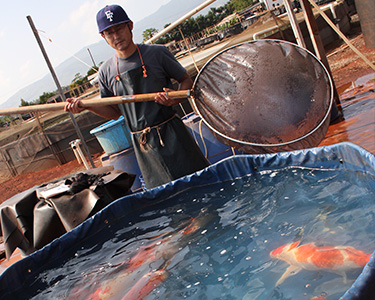 Using Net to Collect Koi
Using Net to Collect Koi
When attempting to collect your fish, BE PATIENT and coax the fish into your netting.
Koi will be (understandably) weary of the net, and they can become very stressed and tired if you chase and force them into the net. This would start your fish off on a bad foot for travel, and increase the chances of it getting ill or worse on the trip.
Take your time and be gentle to help make the moving a less confusing event for your friends. We offer several pond nets on our pond supplies website. View high quality koi nets
What to do After Transportation of Koi or Returning from Show
Your Koi finally gets to the destination, or the Koi show is over and you’ve gotten your Koi back home safely.
Now what to do to ensure the least amount of stress?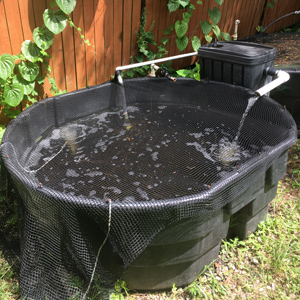
You definitely want to let them rest in the quarantine tank. Traveling is as exhausting and stressful to Koi as it is to humans, and even more so because of the very contained small environment.
When they are exhausted, it is best to provide them a very clean managed space where they can rest and relax. Their immune systems will be lower (from not eating and traveling) and a pond has more pathogens than a quarantine tank.
Get your quarantine space ready with a raised salt level of 0.5% and leave them alone for 2 weeks.
If your quarantine tank has proper filtration, you may feed them. If you are concerned about the ammonia levels from the koi’s excrement, it is safe to not feed them for the two weeks after travel.
Also, bad water quality will cause issues faster than undernourishment, so error on the side of water caution.
If you come back from a Koi show, I would suggest 3 – 4 weeks minimum to ensure there is no risk of Koi Herpes Virus or any other koi disease. This gives you time to watch for symptoms without contaminating the whole pond.
This keeps everyone safe and happy! If you have no filter, you may also want to do light feeding after the two weeks, just change out some quarantine tank water every few days (25% water change should be sufficient with added salts accordingly). If you have a filter for the quarantine tank, there is no need to wait for 2 weeks. You can feed them right away.
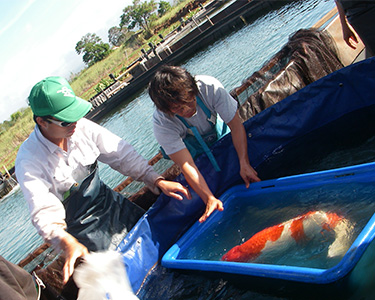
What About a Koi Emergency After Moving?
If you should encounter an emergency or find your Koi very injured, please set up the above mentioned holding tank and transfer the Koi as soon as possible.
At this time, it is very important that water is warm. It would be ideal if it is higher than 70° F. If it is not warm, their immune system does not work and any medicine you use will not work as effectively as it should. Also, understanding why salt is good for your koi pond is very beneficial knowledge.
Tips for Moving Pond Fish in Winter
“Should We Bring Koi Inside During the Winter Months?”
The answer depends, do you have a holding tank with both a filter that is established or can be established and a heater. This koi quarantine kit shows everything you need.
If your answer is yes, then, please bring them in before winter comes. You can set water temperature 50-55° F and feed Manda Fu and Kodama Koi Food all season lightly. If you would like to enjoy feeding more, please set up the water temp at 65° F or higher.
If your answer is no, then, do your best to help prepare your Koi pond for winter. Feed heartily during summer and fall. In the fall, test and treat the pond water to make sure there are no parasites. Now your Koi can rest well until the next spring!
For the spring, follow this guide to Spring Koi Pond Prep to insure a healthy transition.
“Is it Safe to Move Koi Fish if Water is 50° F or Below?”
Seeing your fish relaxing quietly at the bottom of the pond, you may wonder if it is safe to disturb them or transport your koi during the winter. It is true that moving during winter has higher stress for your fish so, if it is possible, moving them before or after is a preferred method.
Basically, I would not recommend moving Koi in winter. If they can wait until spring, wait. Please do not move them.
If you must move or transport your koi to either a new home or for another important reason, you can help them by:
1. Use Pond Water: Try and use some (25-50%) water from the pond you removed them from. Keeping their living medium as consistent as possible will reduce stress and shock.
2. Allow to Rest in Quarantine Before Going into New Home: If possible, follow the same steps as you would from returning from any transportation. Use a quarantine tank setup to give the koi a peaceful place to rebuild their immune system and be less stressed in the controlled environment.
3. Wait Until Spring: You can release into your pond once the water has warmed up and you have started your usual Spring Pond Prep Maintenance. If you can wait until spring to add them to the new pond, this is best. If it is not possible it’s ok, in lower temperatures, your koi fish’s immune will not heal, but it will usually not get worse either.
In cold temperatures, koi are slow moving anyway and should be easy to catch. No need for extra aeration as cold water has a lot of dissolved oxygen. In summer we need a lot of oxygen because warm water holds less oxygen.
Interested in More Koi Health Tips?
Read our koi information guide and see all the top blogs we have produced for helping you manage koi ponds.
Let us know your questions and comments down below:

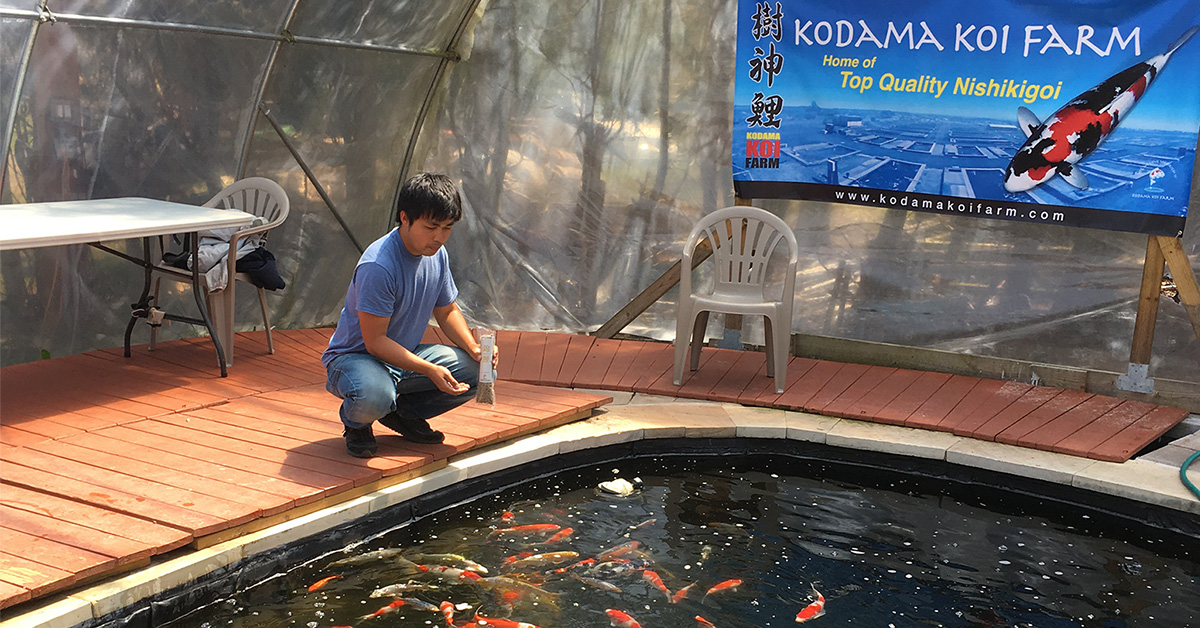
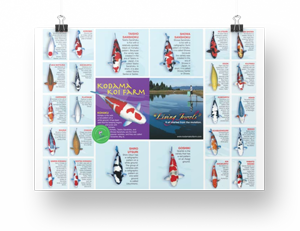

I want to know more about how to transfer shift fish long distance equipment details and cost. Is it covered to avoid water loss during travel
Hello, I am not sure if I understand your questions. What is “shift fish”?
I live in scotch plains nj moving about 30 koi fish from my pond how can I get them to north Carolina its about 11 hours for the ride I have a pick up
Hello, if I were you, I would box them up and drive down. The difficult part is to pack your Koi. do you have any local Koi professionals who can pack Koi properly? if so, it may be the easiest and the safest to hire them.
In the spring im moving from essex ct to terrell tx 18 kois what is the best way /Thanks jackie
How to send my koi from Japan to Philippines? What shipping company that send alive koi?
Hi, you need a Koi broker in Japan who can arrange all that. Who are you buying the Koi from? The seller should be able to help you.
Is it a bigger problem to move 20 year old koi?
I am not sure what you mean by “bigger” problem. But you certainly need to be careful when you are moving older Koi.
Hi I am in India. I want to buy small koi fish not very big how many I can put in one bag and is it safe to travel more than 20 hrs in winter.and how can I buy koi fish from Japan.
Thanks
Each country has different regulations. so it is very hard to say, but you need to find a good broker in Japan who can assist you to import Koi to your country. If Koi are properly prepared and packed, 20 hours should be no problem.
I’ll be moving some koi from NY to Ohio later on in spring. These are coming from two ponds, and the bigger ones are between 14-20″ and the smaller ones from the smaller pond between 4-12″.
Could you recommend correct box and bag sizes for these, and do you sell these at your NY or NJ stores?
Hi, 1 large box should be fine. maybe 12 x 12 x 28. Please visit our NY store and ask for a help from my manager.
Hi my neighbor is moving and is giving us his koi they are around 20″ is it a good idea to use a large cool to move them across the street to our pond and then just add some of our water to acclimate them to our pond ? and if so how long should i let them stay in the cooler befor putting them in ? its been pretty hot here and i don’t want them to be stressed too much
The cooler should work. For acclimation, 10-15 min should be enough for you. However, you are bringing a new Koi from one pond to the other. You do not know what the new Koi has been exposed. I would suggest you quarantine the Koi in a separate holding tank. Please read this article. https://www.kodamakoifarm.com/koi-quarantine-tank-setup-procedure/
I am moving from San Diego California to Baja California Sur. I have 8 Koi that are 15” and smaller Koi 8”. It takes me 2 days to drive because it’s so dangerous to drive at night. I plan to move them in plastic bags with oxygen and make a crate with a pond liner and place all the bags inside in the dark. Is it safe to transport them? Do I need to fill out Customs forms for each fish?
I think it is safe to transport them. Please make sure you cut the food at least 1 week before the trip. Just in case, you may want to carry your oxygen tank so that you can rebag them if needed. As for the custom form, I am not sure. Every country has different rules.
I just watched the video. Do you sell the Koi Boxes and bags?
Also we have an Oxygen Tank here can I use it to fill the bags with oxygen?
Hello, yes we sell bags at https://www.kodamakoisupply.com/koi-transportation-bags/
As for boxes, we do not sell them online, but if you like, we can. If you have oxygen tanks, yes you can use it.
I live in Maryland. I need to move a large number of koi from my pond to be released into a two acre pond/preserve about 2 hrs drive. Approximately 12 of the koi are greater than 22” the remaining larger koi approx 15 more are smaller down to 5”. Can I have them moved in mid March? Or is it too cold?
Hi
Please contact our customer service by email info@kodamakoifarm.com so that we can further assist you.
We look forward to help with your questions.
Hi I have 4 large koi about 30 pounds a piece and over 20 years old. Have 2 smaller koi about 15 inches. I do have a 150 gallon rubber tank that I use to place them in when cleaning the 3000 gallon pond once a year. Should (or can I) use the tank and travel 12 hours from Salem, MA. to New Bern NC ? They most likely will be in a U Haul truck. OR is there a company that can do it for me near my area? This will be done around November. Thank you.
Hi Patrick, sorry for the late reply, for quicker assistance please email info@kodamakoifarm.com
Your plan for ground transportation sounds do-able. You may want to use koi-sleep to relieve stress on movement.
Also would suggest a covering such as a net.
hello Taro san…may I ask what is in the white packet I often see inside the koi fish bag when you are packing the fish? Thanks for your advice.
Hi, we do not put anything in the bag with koi. Koi orders have a separate package outside of the bag for quarantine instructions.
Hi,
I live in Northern California and moving to Southern California near Palm Springs.
As this is a desert climate, the fall, winter and spring weather is relatively mild with temperatures rarely below 45F and daily no more than 65-70F. In the summer, however, daily temperatures can reach up to 130F, sometimes more.
So, I have one male butterfly koi left (long sad story about losing his female mate and one offspring). He is over 15 years old and has been in the same 300 gallon pond since he was little.
He was moved 10 years ago by a professional koi pond service person using the bag method (but he was considerably smaller to and only a 1 hr car ride) but the koi person is no longer active.
I over-filter the pond and can aerate for the summers-there are wild animals such as koyotes, bobcats and other. I have successfully kept out racoons in present location (after they took my baby koi) by building a PVC open cover overlayed with netting-not sure if this would be enough out in the desert though.
I tried to find him a home in Northern California and spare him the long drive (12 hrs) and possible danger of wild animals but have had no takers so far. I may have no choice but to bring him along.
So, having read all the good info above, it seems that moving him in a large cooler, should work, although I approach that with some trepidation-likely stressful for him and me.
The biggest questions are:
Will he be able to survive 4 months of 100+F temperatures, even with aeration?
What are the chances the current PVC cover which is attached to the pond will prevent wild animals from getting into the pond?
Thanks